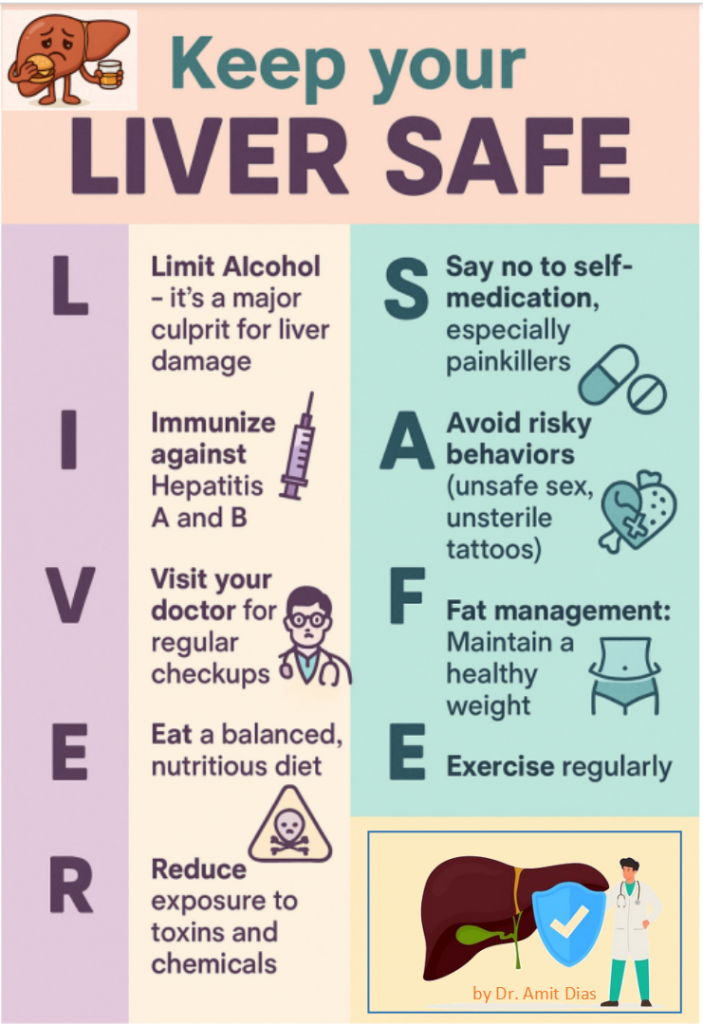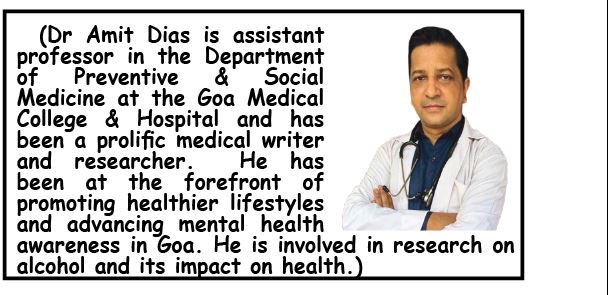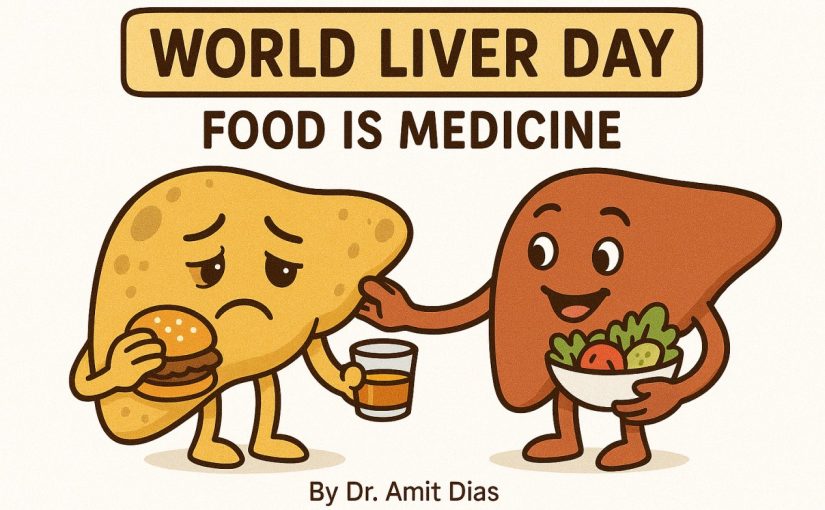Q&A Interview with Dr Amit Dias on `World Liver Day’!
April 19 is observed as World Liver Day where we celebrate one of the unsung heroes of our digestive system — the liver. We spoke to Dr Amit Dias who has specialized in Preventive Medicine to throw light on our liver – “Our liver works 24×7 to keep us healthy; we must work just as hard to keep our LIVER SAFE,” he says.
In this exclusive interview, we bust common alcohol myths, uncover the truth about hepatitis, understand rising concern of fatty liver, and learn practical tips to protect this life-saving organ.
This is more than just an article — it’s a health wake-up call. Read it, share it and help save not just your own life, but the lives of those you care about.
Goan Observer: Please help us understand just how vital the liver is to our overall health and bodily functions?
Dr Amit Dias: The liver is vital—literally and figuratively. It’s the largest internal organ and is involved in over 500 functions in the body. These include detoxifying harmful substances, metabolizing drugs, storing vitamins and minerals, producing bile to help digest fats, and managing blood clotting. You are what your liver lets you be. This hard-working, unsung hero of the human body filters and detoxifies everything we consume, breathe and absorb, from your favorite spicy biryani to your late-night wine. And yet, most of us only start paying attention to our liver when it starts waving a yellow flag in the form of jaundice. The theme for World Liver Day this year is “Food is Medicine.”
Q: That’s interesting- can you elaborate on the theme…How is Food Medicine and what is the connection with the Liver?
A: “Food is Medicine” is a fitting theme for World Liver Day, as the liver processes everything we eat. A healthy diet protects the liver, while poor nutrition can lead to non-alcoholic fatty liver disease (NAFLD, now called –Metabolic Dysfunction Associated Steatotic Liver Disease (MASLD), liver inflammation, and cirrhosis. Diets high in sugar, unhealthy fats, and processed foods increase liver fat and damage.
In contrast, foods rich in antioxidants, fiber and healthy fats – for example, leafy greens, berries, turmeric and fatty fish — support liver function and repair. Avoiding alcohol and maintaining a healthy weight are the key. With the right food choices, liver damage can often be prevented or even reversed, showcasing food’s healing power.
You can think of it as your body’s chemical processing plant and waste treatment facility rolled into one. And unlike other organs, it has a unique superpower — it can regenerate. But even superheroes have their limits… that’s when we get into trouble. We need to protect our liver and keep it safe in order to prevent disease.
Q: How can we protect our liver and keep it safe?
A: This is the star question! Let me use the word LIVER SAFE to help people remember how to take care of their liver:
L – Limit Alcohol – it’s a major culprit for liver damage.
I – Immunize against Hepatitis A and B
V – Visit your doctor for regular checkups
E – Eat a balanced, nutritious diet
R – Reduce exposure to toxins and chemicals
S – Say no to self-medication, especially painkillers
A – Avoid risky behaviors (unsafe sex, unsterile tattoos)
F – Fat management: Maintain a healthy weight
E – Exercise regularly
Q: Why does alcohol damage the liver and what kind of damage does it cause?
A: Alcohol is metabolized in the liver, and this process produces toxic substances like acetaldehyde that can inflame and damage liver cells. Repeated exposure leads to fatty liver, alcoholic hepatitis, and eventually cirrhosis, which is irreversible scarring. Chronic alcohol use is one of the leading causes of end-stage liver disease globally.
Q: How many years can one safely drink before it harms the liver?
A: That’s the trick question—there’s no “safe number” of years. Some may develop damage after 5–10 years of heavy drinking; for others, it could take 20–30 years—or never. Genetics, gender, diet, co-existing infections like Hepatitis C and other lifestyle factors all influence this. Women, due to lower levels of alcohol-metabolizing enzymes, are more vulnerable.
Q: How much alcohol is considered harmful?
A: From a medical standpoint, any amount of alcohol can potentially be harmful, especially if there’s an underlying liver condition. According to national and international health guidelines, no amount of alcohol is completely safe for liver health, but for those who do drink, moderation is key. The recommended upper limits for Indian adults are:
Men: No more than 2 standard drinks per day
Women: No more than 1 standard drink per day
One standard drink =
• 30 ml of spirits (whisky, vodka, etc.)
• 100 ml of wine
• 285 ml (a regular glass) of beer
Also note that individuals with liver conditions, viral hepatitis, or those on liver-affecting medications should avoid alcohol entirely. Always consult a doctor.
Q: How big is the problem of liver disease?
A: Liver diseases account for approximately 2 million deaths annually, representing about 4% of all global deaths. The primary culprits are complications from cirrhosis and hepatocellular carcinoma (HCC)
If you look at the risk factors like alcohol consumption, approximately 2 billion people consume alcohol worldwide, with over 75 million diagnosed with alcohol-use disorders, increasing their risk for alcohol-associated liver. disease.
Obesity and Diabetes — Around 2 billion adults are overweight or obese, and over 400 million have diabetes, both of which are significant risk factors for non-alcoholic fatty liver disease (NAFLD) and Liver Cancer.
India reports approximately 264,193 deaths annually due to liver diseases, accounting for 3% of all deaths in the country. Liver disease ranks as the 10th leading cause of death in India
Q: Is this damage to the liver reversible?
A: Yes, but only to a point. The liver can regenerate, so if the insult (like alcohol or a virus) is removed early, the liver can repair itself. But once significant fibrosis or cirrhosis sets in, that damage becomes permanent and leads to complications like liver failure or cancer.

Q: What are the common liver diseases besides alcohol-related ones?
A: They include:
–Metabolic Dysfunction Associated Steatotic Liver Disease (MASLD) (earlier called NAFLD)
–Hepatitis (A, B, C, D, E)
–Liver cancer (often secondary to hepatitis B or C)
–Autoimmune hepatitis
–Drug-induced liver injury (for example, from acetaminophen)
Q: Are there vaccines for liver diseases?
A: Yes! Vaccines for Hepatitis A and B are highly effective. Hep B is part of the routine immunization schedule — the first dose is given at birth. Adults in high-risk categories (healthcare workers, travelers, IV drug users) should get vaccinated too. Sadly, Hepatitis C has no vaccine, which makes prevention even more critical. However, we now have very good drugs and can treat hepatitis.
Q: How is fat related to liver disease —specifically NAFLD?
A: This is the bad news that Non alcoholics can also get liver disease and cirrhosis. NAFLD (Non-Alcoholic Fatty Liver Disease) is now the most common liver disease worldwide, even in children. It’s associated with obesity, type 2 diabetes and poor diet. Over time, it can progress to NASH (non-alcoholic steatohepatitis), fibrosis, cirrhosis and even cancer.
In our community-based study in Goa, we found several people with fatty liver changes, many of whom were unaware. This shows the silent nature of the disease. The prevalence was higher in individuals with diabetes, central obesity and sedentary lifestyles.
Q: What are some early symptoms of liver disease that people should watch out for?
A: Unfortunately, up to 50% of people with liver disease have no symptoms. Common symptoms include:
Fatigue, lack of energy, itching, jaundice (yellow eyes/skin), dark urine, pale stools, abdominal swelling, confusion in late stages. By the time symptoms show, damage may already be significant.
Q: What’s your message to our readers this World Liver Day?
A: Out liver works 24×7 to keep us healthy; we must work just as hard ot keep our LIVER SAFE. Let’s:
Get screened, especially if overweight or diabetic
Say No to unnecessary medications and alcohol
Say Yes to vaccination and healthy living
Remember what I said about keeping your LIVER SAFE — because the best liver is the one you never notice, and that’s exactly how it should stay.
“Let’s give our liver less to filter and more to celebrate!”

